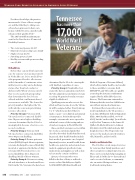Page 208 - Cityview_July_Aug_2015
P. 208
Warrior Care: Benets Available to America’s Aging Veterans
190
CITYVIEWMAG.COM JULY AUGUST 2015
For those Stout helps, the pension means much: “Some of these caregiv- ers and the folks they’re taking care
of have been prisoners in their own homes. A little bit extra a month really enhances their quality of life.”
The 2015 monthly maximum pay- outs for the Non-Service–Connected Disability Pension:
• Twoveterans/spouses:$2,837
• Marriedveteranneedingcare:$2,120
• Singleveteran:$1,788
• Survivingspouse:$1,149
• Healthyveteranwithspouseneeding
care: $1,404
VA Health Care
Before they can enroll in long-term care for seniors, veterans must enroll in VA health care. It is a medical ben- efits program offered to all veterans with 24 months of continuous active military service duty and a discharge status other than bad conduct or dishonorable. When veterans enroll, they receive a priority group rating that determines the level of care offered and that can fluctuate based on resources available. The lower the priority number, the higher the VA will rank the veteran in prioritizing resource allocation:
Priority Group 1: Veterans with VA-rated service-connected disabil- ities 50 percent or higher disabling; veterans determined by the VA to be unemployable because of service-con- nected conditions.
Priority Group 2: Veterans with VA-rated service-connected disabilities 30 or 40 percent disabling.
Priority Group 3: Former prisoners
of war (POWs); Purple Heart recipients; veterans discharged because of disability incurred or aggravated in the line of duty; veterans with VA-rated service-con- nected disabilities 10 or 20 percent disabling; Medal of Honor winners.
Priority Group 4: Veterans receiving aid and attendance or housebound bene- fits from the VA. Veterans who have been
determined by the VA to be catastrophi- cally disabled, regardless of cause.
Priority Group 5: Nondisabled vet- erans who have an annual income below the VA’s adjusted income limits; veterans receiving VA pension benefits; veterans eligible for Medicaid.
Qualifying veterans who are not dis- abled and have income above the VA lim- its will be assigned either Priority Group 7 or 8—which means they’ll have to make co-pays—or, in limited and unusual circumstances, Priority Group 6 (for example, veterans who were exposed to radiation because of the testing and use of nuclear weapons in World War II).
Once enrolled, veterans receive within two weeks a customized guide that describes how their health benefits work. In general, their health benefits include basic medical, preventive care, hospital (inpatient) services, mental health, home health care, geriatrics and extended care, medical equipment, prosthetic items, medications and supplies, as well as den- tal care under certain conditions.
Spouses of veterans who were killed in the line of duty or suffered a service-related disability are eligible for CHAMPVA (Civilian Health and
Medical Program of Veterans Affairs), which offers similar health-care benefits to those available to veterans. Both CHAMPVA and VA health care qualify as meeting the insurance minimums required by the Affordable Care Act. Even so, The Tennessean estimated in February that the state has 29,000 veter- ans without any medical insurance.
For Knoxville veterans who do not need hospitalization, the VA operates a local clinic (William C. Tallent Outpatient Clinic, 8033 Ray Mears Blvd., 865-545- 4592), but the “mother ship” (as staff refer to it) for East Tennessee is the James H. Quillen VA Medical Center in Johnson City (423-926-1171), which includes full hospital services. The VA provides van service to the medical center from Knox- ville, Maryville, and Sevierville.
Geriatrics and Extended Care
The VA offers a wide range of services for veterans, their family members, and other caregivers needing long-term care. These services include help managing an illness and aid with day-to-day tasks and can be received at home, a community site, an assisted-living residence, or a traditional nursing home.
Tennessee has more than
17,000 World War II Veterans


